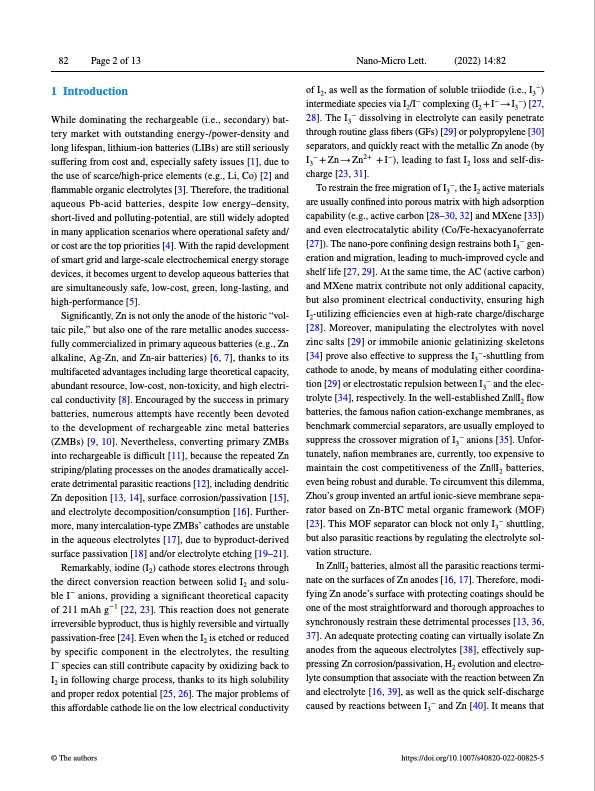
PDF Publication Title:
Text from PDF Page: 002
82 Page 2 of 13 1 Introduction While dominating the rechargeable (i.e., secondary) bat- tery market with outstanding energy-/power-density and long lifespan, lithium-ion batteries (LIBs) are still seriously suffering from cost and, especially safety issues [1], due to the use of scarce/high-price elements (e.g., Li, Co) [2] and flammable organic electrolytes [3]. Therefore, the traditional aqueous Pb-acid batteries, despite low energy–density, short-lived and polluting-potential, are still widely adopted in many application scenarios where operational safety and/ or cost are the top priorities [4]. With the rapid development of smart grid and large-scale electrochemical energy storage devices, it becomes urgent to develop aqueous batteries that are simultaneously safe, low-cost, green, long-lasting, and high-performance [5]. Significantly, Zn is not only the anode of the historic “vol- taic pile,” but also one of the rare metallic anodes success- fully commercialized in primary aqueous batteries (e.g., Zn alkaline, Ag-Zn, and Zn-air batteries) [6, 7], thanks to its multifaceted advantages including large theoretical capacity, abundant resource, low-cost, non-toxicity, and high electri- cal conductivity [8]. Encouraged by the success in primary batteries, numerous attempts have recently been devoted to the development of rechargeable zinc metal batteries (ZMBs) [9, 10]. Nevertheless, converting primary ZMBs into rechargeable is difficult [11], because the repeated Zn striping/plating processes on the anodes dramatically accel- erate detrimental parasitic reactions [12], including dendritic Zn deposition [13, 14], surface corrosion/passivation [15], and electrolyte decomposition/consumption [16]. Further- more, many intercalation-type ZMBs’ cathodes are unstable in the aqueous electrolytes [17], due to byproduct-derived surface passivation [18] and/or electrolyte etching [19–21]. Remarkably, iodine (I2) cathode stores electrons through the direct conversion reaction between solid I2 and solu- ble I− anions, providing a significant theoretical capacity of 211 mAh g−1 [22, 23]. This reaction does not generate irreversible byproduct, thus is highly reversible and virtually passivation-free [24]. Even when the I2 is etched or reduced by specific component in the electrolytes, the resulting I− species can still contribute capacity by oxidizing back to I2 in following charge process, thanks to its high solubility and proper redox potential [25, 26]. The major problems of this affordable cathode lie on the low electrical conductivity Nano-Micro Lett. (2022) 14:82 of I2, as well as the formation of soluble triiodide (i.e., I3−) intermediate species via I2/I− complexing (I2 + I− → I3−) [27, 28]. The I3− dissolving in electrolyte can easily penetrate through routine glass fibers (GFs) [29] or polypropylene [30] separators, and quickly react with the metallic Zn anode (by I3− + Zn → Zn2+ + I−), leading to fast I2 loss and self-dis- charge [23, 31]. − To restrain the free migration of I3 , the I2 active materials are usually confined into porous matrix with high adsorption capability (e.g., active carbon [28–30, 32] and MXene [33]) and even electrocatalytic ability (Co/Fe-hexacyanoferrate [27]). The nano-pore confining design restrains both I3− gen- eration and migration, leading to much-improved cycle and shelf life [27, 29]. At the same time, the AC (active carbon) and MXene matrix contribute not only additional capacity, but also prominent electrical conductivity, ensuring high I2-utilizing efficiencies even at high-rate charge/discharge [28]. Moreover, manipulating the electrolytes with novel zinc salts [29] or immobile anionic gelatinizing skeletons [34] prove also effective to suppress the I3−-shuttling from cathode to anode, by means of modulating either coordina- tion [29] or electrostatic repulsion between I3− and the elec- trolyte [34], respectively. In the well-established Zn||I2 flow batteries, the famous nafion cation-exchange membranes, as benchmark commercial separators, are usually employed to suppress the crossover migration of I3− anions [35]. Unfor- tunately, nafion membranes are, currently, too expensive to maintain the cost competitiveness of the Zn||I2 batteries, even being robust and durable. To circumvent this dilemma, Zhou’s group invented an artful ionic-sieve membrane sepa- rator based on Zn-BTC metal organic framework (MOF) [23]. This MOF separator can block not only I3− shuttling, but also parasitic reactions by regulating the electrolyte sol- vation structure. In Zn||I2 batteries, almost all the parasitic reactions termi- nate on the surfaces of Zn anodes [16, 17]. Therefore, modi- fying Zn anode’s surface with protecting coatings should be one of the most straightforward and thorough approaches to synchronously restrain these detrimental processes [13, 36, 37]. An adequate protecting coating can virtually isolate Zn anodes from the aqueous electrolytes [38], effectively sup- pressing Zn corrosion/passivation, H2 evolution and electro- lyte consumption that associate with the reaction between Zn and electrolyte [16, 39], as well as the quick self-discharge caused by reactions between I3− and Zn [40]. It means that © The authors https://doi.org/10.1007/s40820-022-00825-5PDF Image | Boosting Zn Battery by Coating a Zeolite‐Based Cation‐Exchange

PDF Search Title:
Boosting Zn Battery by Coating a Zeolite‐Based Cation‐ExchangeOriginal File Name Searched:
Shang2022_ZnI-Battery.pdfDIY PDF Search: Google It | Yahoo | Bing
CO2 Organic Rankine Cycle Experimenter Platform The supercritical CO2 phase change system is both a heat pump and organic rankine cycle which can be used for those purposes and as a supercritical extractor for advanced subcritical and supercritical extraction technology. Uses include producing nanoparticles, precious metal CO2 extraction, lithium battery recycling, and other applications... More Info
Heat Pumps CO2 ORC Heat Pump System Platform More Info
| CONTACT TEL: 608-238-6001 Email: greg@infinityturbine.com | RSS | AMP |